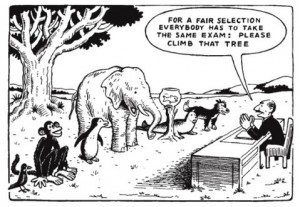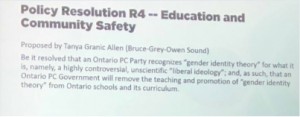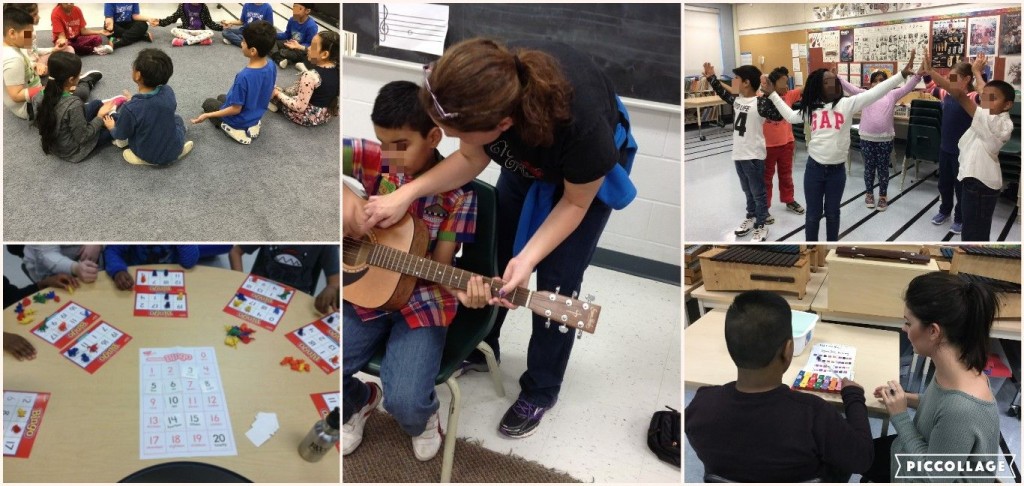
Large scale assessments, like EQAO testing, were developed to support standards-based education reform on the premise of setting high standards and establishing measurable goals in order to improve learning outcomes in education.
This blog highlights how EQAO testing does not achieve its goals and, in fact, hinders learning outcomes, especially in marginalized student populations.
1. EQAO testing is unfair to students with special education or English language needs
In EQAO testing, all students are treated equally. This means that students with low intellectual levels or learning disabilities are made to write the test. Students who have low levels of English knowledge are made to take the test. There are some exemptions for students which are hard to obtain and when students are exempt, students’ tests scores of zero are counted in their school’s overall scores. These barriers to learning result in lowering school’s test scores.
Treating students all the same does not differentiate learning needs. Students who cannot read or write, due to an exceptional learning need are made to take the test. For example, I had one student, who was non-verbal, sit in front of a computer for three hours unable to complete any part of the grade 3 EQAO test. I have also had students who just came to Canada from a non-English speaking country, sit in front of their EQAO test paper with a blank look. Schools with many special education classrooms or high levels of English language learners have lower school scores, as these students, due to their circumstance, cannot complete the EQAO tests.
The bottom line is that EQAO testing is unfair for many students.
2. EQAO testing is unfair to students with low socioeconomic factors
In EQAO results, there is a direct link between low test scores and low socioeconomic factors. Socioeconomic status impacts language development which results in decreases in vocabulary, phonemic awareness, and an overall ability to read and comprehend text (Perkins, Finegood, & Swain, 2013). In addition, “The family stress model connects poverty with parental emotional distress that affects parenting, whereas the parental investment model involves a focus on basic needs that affects children’s language (Perkins, Finegood, & Swain, 2013, p. 1). The result of this disadvantage of poverty is that schools in areas with low socioeconomic status tend to have low EQAO test scores (Langois, 2017). Schools in wealthier areas tend to have higher EQAO scores than schools in lower socioeconomic areas.
This is why real estate agents use EQAO test scores to sell residential property – to assess the socioeconomic status of a neighbourhood.
The bottom line is that EQAO measures socioeconomic status.
3. EQAO does not honour education policy
Through the Policy/Program Memorandum No. 119, Developing and Implementing Equity and Inclusive Education Policies in Ontario Schools, it is stated that there is a need for our “publically funded education system to support and reflect the democratic values of fairness, equity, and respect for all” (Ministry of Education, 2013).
The bottom line is that EQAO testing procedures do not “reflect the democratic values of fairness, equity, and respect for all.”
4. EQAO diverts schools’ resources and energy away from meeting students’ learning needs
EQAO testing focuses schools’ resources and energy on doing everything to increase test scores. In my years as a teacher, I find that EQAO takes over schools and students’ learning. Grade 3 and 6 teachers become obsessed with cramming curriculum into the year before the test. Some administrators direct teachers to only teach math and language, while students miss out on social studies and science. Redirecting learning turns teaching into test focused, score based tunnel vision.
This test focused, score based tunnel vision has other impacts on school practices. There is a great deal of documentation in the Ontario College of Teachers citing teachers and principals who have changed students EQAO test answers so their school will receive more favourable test score rankings.
Why do educators cheat?
Cheating is a big problem in government testing. Teachers and principals alter students’ answers to get better results. Cheating happens internationally. Low test scores in the US have caused teachers and principals to get fired. High stakes testing puts great pressure on educators to produce good EQAO scores.
The bottom line is that EQAO highjacks teachers’ teaching and students’ learning.
5. EQAO is not a standardized, statistically measured test format
EQAO test results are very difficult to decipher and it is often unclear how the test scores really inform educators about student learning.
Ontario’s Education Quality and Accountability Office, the source of the EQAO testing, does not cite any reliability or validity results that ensure the test questions are actually measuring the intended skills. A test is valid if it measures what it is supposed to measure. The EQAO website does not cite checks of Test-Retest Reliability, Cronbach’s alpha for measuring of internal consistency, Convergent reliability, or Confirmatory Factor Analysis.
I wonder about the consistency or reliability of EQAO test marking. Reliability in testing means that two identical student answers would be marked the same or in other words, test marking would be consistent. I wonder if EQAO has sufficient test procedures, checks, and tests in place to ensure reliability.
Further, I wonder how much EQAO test scores are used to inform teacher practice. Some schools use the results by breaking down specific areas of need but this takes time meaning in order to do a proper job of this analysis, teachers would need to be released from their teacher duties to do this work. Further, it would be beneficial for teachers to have some knowledge of statistics in order to assess their school’s results.
Ontario students do participate in international testing PISA (Program for International Student Assessment), TIMSS (the Trends in International Mathematics and Science Study), and PIRLS (the Progress in International Reading Literacy Study) and Canada usually does well, ranking in the top 10. Note that some of the scores in the Asian countries do not reflect all students as poorer students or students with disabilities do not participate in this testing for many reasons. Canada still does well compared to those countries.
Finally, I also wonder why a statistically minded organization like EQAO uses the words “standardized” tests to describe their testing. To be standardized, these tests would have to be statistically normalized on a bell curve like CAT (Canadian Achievement Test) and CCAT (Canadian Cognitive Ability Test) tests.
The bottom line is that the EQAO test structure is not statistically reliable or valid.
6. EQAO testing costs offers questionable return on investment
In considering the above points, EQAO offers questionable return on the public’s investment. EQAO testing cost $30,000,000 in 2014. That’s a lot of money that the province could be using to fix schools.
My question: Do the EQAO test results merit $30 million dollars worth of data?
Overall, I do not see the value of EQAO testing. As a teacher, I have never used the scores – sometimes I never get to see the scores.
Let’s put our education dollars into areas where the funds can improve learning. The real estate agents will have to think of another way to sell residential listings.
Collaboratively Yours,
Deb Weston
References
Alphonso, A. (April 21, 2018). Government-commissioned report recommends Ontario should phase out Grade 3 EQAO test, Globe and Mail. Toronto. Downloaded from https://www.theglobeandmail.com/canada/article-government-commissioned-report-recommends-ontario-should-phase-out/
Hassan, F. (February 6th, 2014). It’s time to scrap province-wide testing, Toronto Sun. Downloaded from https://torontosun.com/2014/02/06/its-time-to-scrap-province-wide-testing/wcm/dc995597-1dd0-4fa4-8afb-801a797611d3
Langois, H. (2017). Behind the Snapshot: Teachers’ Experiences of Preparing Students in Lower Socioeconomic Status Schools for the Ontario Secondary School Literacy Test. University of Toronto, Ontario.
Ontario Education Quality and Accountability Office. (2013) Top Reasons Standardized Testing in Ontario and the United States Are Not Comparable, Education Quality and Accountability Office, Ontario. Downloaded from http://www.eqao.com/en/about_eqao/media_room/communication-docs/infographic-EQAO-US-Comparison-print-version.pdf
Ontario Ministry of Education. (April 22, 2013). Ministry of Education Policy/Program Memorandum No. 119: Developing and implementing equity and inclusive education policies in Ontario Schools, Ontario Ministry of Education. Downloaded from http://www.edu.gov.on.ca/extra/eng/ppm/119.pdf
Perkins, S. C., Finegood, E. D., & Swain, J. E. (2013). Poverty and language development: Roles of parenting and stress. Innovations in clinical neuroscience, 10(4), 10.
Wong, A. (2016). Why would a teacher cheat? The Atlantic.






